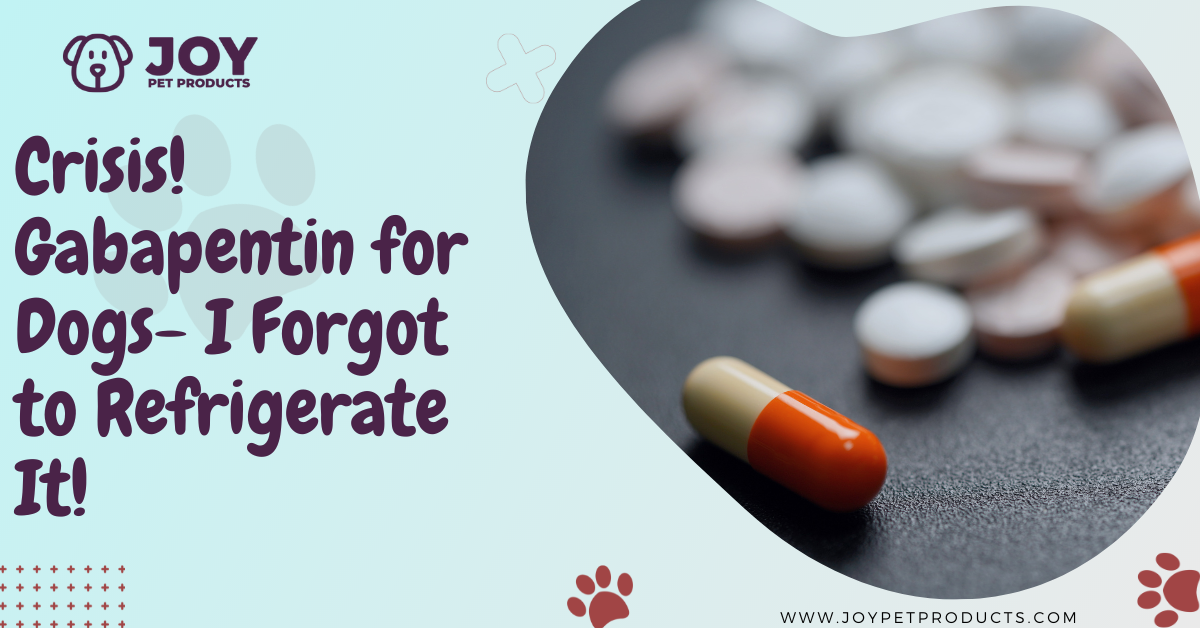Despite your vet’s specific instructions regarding the gabapentin that he prescribed for your dog, you wake up one morning to find the packet sitting neatly on the countertop.
Instead of in the fridge. Where it’s meant to be!
Relax.
Thankfully, the situation is not as dire as it may appear to be in your mind. At most, gabapentin that has been left out at room temperature will begin to lose its potency and effectiveness. At no point will it become poisonous or dangerous for your pup.
However, that doesn’t mean that you should still continue giving it to your dog. As touched on, the medication may have already lost much of its positive effects. Therefore, it would be best to contact your vet and enquire about getting new doses of the drug.
What Is Gabapentin?

Gabapentin is a commonly-prescribed drug for both humans and animals- though in different concentrations, of course!
Gabapentin is a type of anti-seizure medication commonly used to treat seizures, control epilepsy, and to control neuropathic pain, It can also treat chronic pain, nerve pain and anxiety. Gabapentin exists in capsule, tablet, and liquid forms.
Whether or not the medication needs refrigeration depends largely on the form provided by the vet.
Gabapentin For Dogs VS. Humans
Although certain medications, like some antihistamines, are safe for both you and your canine companion, gabapentin is not one of them.
The type that humans take contains a chemical known as xylitol, which is highly toxic to dogs and can cause liver failure.
How Long Can Gabapentin Be Left Out Of The Fridge?

Unfortunately, there’s no set time frame to refer to since formulas can differ.
If storing your pup’s medication slipped your mind, check with your vet if the specific solution for your pet is still stable.
Try to be accurate when you share the number of hours you left it out. If you’re not sure, be honest with your vet rather than making a guesstimate.
Why Does Gabapentin Need Refrigeration?
Now, gabapentin tablets or capsules don’t usually require refrigeration to store.
However, the liquid—oral suspension—is a different story. In this form, undissolved particles of the active agent (gabapentin) get mixed with a liquid.
The solubility of the drug, or how quickly it dissolves in the liquid, can be influenced by temperature. If these little particles dissolve before your dog has a chance to take them, it defeats the purpose.
For one type of high-concentration oral suspension given to humans, refrigeration can hurt rather than help.
However, the majority of commercial formulas preserve better in the cold- temperatures from 36 to 46 degrees Fahrenheit.
The concentration plays a role in proper storage: lower concentrations (below 50mg of gabapentin per milliliter of oral solution) require refrigeration.
Bearing in mind the species and weight difference, dogs are rarely prescribed high-concentration solutions. A typical dosage for the oral solution in epileptic dogs is 10mg per kilogram or 2.2 pounds.
What Happens if Gabapentin Is Not Refrigerated?
Unrefrigerated gabapentin isn’t dangerous, but it might not be as potent. That means that it might not benefit your pet much as pain medications or anti-seizure agents.
If your vet already told you how long your gabapentin would last outside the fridge and you suspect you’ve gone over that, it’s better not to give it to your pup. It won’t help them, and if your dog is a fighter when it comes to taking medicine, the hassle will be for nothing.
How Do You Store Liquid Gabapentin?

As we touched on, some formulas can be stored outside the fridge at room temperature. That isn’t usually the case for solutions intended for dogs, as lower concentrations usually require colder temperatures to remain stable.
Always check with your vet about correct storage. Don’t keep gabapentin for dogs in the freezer unless you want a pain-relief popsicle for your pup.
What Is The Shelf Life Of Gabapentin?
The shelf life depends on the formula. Generally, oral solutions have considerably shorter lifespans than tablets or capsules– some of which can be kept out for years.
You can check the packet to see when it’s due to expire. Note that the expiration date takes into account proper storage—if it’s left out of the fridge too long, it may already be useless.
Prevent A Repeat Incident
You can decrease the chances of forgetting to refrigerate gabapentin with these simple tips:
Don’t Stray From The Fridge
Rather than hauling the whole bottle out, take the needed dosage at the fridge and then pop it back in. Whether you’re pouring it into wet food or going for the syringe route, you can collect the dose standing at your fridge.
Set A Reminder
If you’re still not confident you’ll remember to refrigerate it, set a reminder on your phone 10 to 15 minutes after your dog’s dosage time. That’s a sufficiently short time that you can rest assured the gabapentin will still be stable.
Gabapentin In Dogs:

Here, we answer some common questions pet owners have about this drug.
FAQ’s
What Are The Potential Side Effects Of Gabapentin In Dogs?
Acute, common side effects of gabapentin in dogs include a lack of coordination and drowsiness. However, gabapentin is generally well-tolerated in canines when the dosage is correct.
The long-term effects of this drug on dogs are not yet established. A small study revealed some dogs experienced neurological effects- much the same as in people taking gabapentin.
How Much Gabapentin Is Safe For A Dog?
The dosage will depend upon your companion’s age, weight, and health condition. Gabapentin isn’t the sort of drug you can give to your dog without veterinary supervision.
How To Give Gabapentin For Dogs

Firstly, most preparations require that you shake the bottle beforehand. That’s to distribute the particles evenly throughout the solution.
Next, your dog will have to take their meds at set times, e.g., every eight hours. If you skip a dose, don’t double-up the next time—set reminders if that keeps happening.
The actual administration process will depend on your canine’s character. If your dog is less discerning, you can mix it into wet food for discreet dosing. If you opt for this tactic, keep the portion size small to ensure nothing gets left behind.
If you have the type of dog who won’t fall for simple tricks, you can use the plastic syringe method:
- Hold your dog securely so that they don’t move around: enlist help if necessary.
- Gently grasp your dog’s head to keep it still, and place the syringe’s nozzle in the gap behind their large front teeth.
- Slowly press down on the syringe plunger to allow your pup time to swallow and breathe.
- If your pup spits afterward, don’t administer another dose unless you’re entirely sure that your dog swallowed little or none of the dosage. If your dog is a stubborn spitter, you can hold their jaws shut and wait until you see them swallow.
Summary
If you forgot to refrigerate the gabapentin meant for your dog: don’t fret too much! Depending on how long you have left it out for, it may have simply lost some of its potency.
Losing its potency means that it may now not be as effective for treatment as it was before. Therefore, the best thing to do would be to visit your vet again to pick up a new dose of the medication so that your dog can receive the best treatment possible!
Heather Abraham is a professional blogger who owns two dogs, a cat, a parrot, and a leopard gecko. She has a connection with animals since she was a child. She shares her love for all pet breeds and provides information on pet food, toys, medications, beds, and everything else.
She is committed to learning about the internal workings of animals. Her work permits her to work closely with knowledgeable vets and obtain practical expertise in animal care. When she is not working, her love of animals continues in her writing. Her goal is to educate and uplift readers who also have a passion for animals through her writing.
